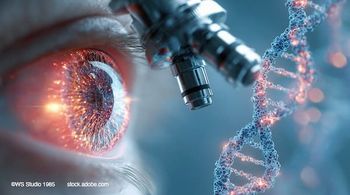
AD-IOLs mimic movement of natural lens
Accommodating-disaccommodating IOLs are being developed that mimic the movement of the young crystalline lens through the use of “Zonular Capture Haptics” technology.
Take-home message: Accommodating-disaccommodating IOLs are being developed that mimic the movement of the young crystalline lens through the use of “Zonular Capture Haptics” technology.
Reviewed by Paul M. Beer, MD
St. Petersburg, FL-Almost a decade ago, Paul M. Beer, MD, set out to develop a pseudophakic IOL for in-the-bag implantation that would replicate the movement of the young crystalline lens.
At the XXXIV Congress of the European Society of Cataract and Refractive Surgeons in Copenhagen last month, Dr. Beer reported on his success using “Zonular Capture Haptics” (ZCH) to create accommodating-disaccommodating IOLs (AD-IOLs).
Related:
Courtesy of Paul M. Beer, MD
Two AD-IOL prototypes are in development. The first is based on axial shift of a single foldable monofocal optic that would meet FDA label requirements. It has been implanted in six animal eyes so far, demonstrates continued efficacy after more than 1 year of follow-up, and is ready for resizing for human eyes.
The second, which is at an early prototype stage, is a dual mode AD-IOL that combines axial shifting and optic shape changing mechanisms. Based on “in silico” studies, the dual mode implant is estimated to produce 10 to 14 D of accommodation. Preclinical animal studies are targeted to begin in the first quarter of 2017.
“ZCH is an enabling technology that harnesses the fibrosis of the capsular bag and responds to ciliary muscle contraction in an unprecedented way, converting zonular forces into optic movement,” said Dr. Beer, founder and chief executive officer, Z Lens LLC, St. Petersburg, FL.
More:
Dr. Beer, who is a retina specialist, noted that compared with a cataract surgeon, he approached the development of an accommodating IOL with a fundamentally different perspective about the capsular bag.
Courtesy of Paul M. Beer, MD
“Because my encounter with capsular bags is usually months or years after cataract surgery, I see the capsule as a tangibly stiff disc that holds an IOL in a rigid straitjacket, restricting implant movement,” he explained.
His solution for enabling axial shift was to cut the fibrosed capsule into sections that could separate, thereby activating optic movement.
Related:
In addition, Dr. Beer thought to harness the fibrosis of the capsular bag so that the tissue could be utilized like Velcro straps to attach the zonules to individually mobile haptics.
His first prototype AD-IOL is a foldable implant positioned into the capsular bag during cataract surgery with a restraining device that keeps the optic temporarily in a flat position. In its resting state, the IOL functions like a monofocal lens.
Recent:
After allowing 4 to 6 weeks for the capsule to collapse, fibrose, and adhere to the haptics, radial capsulotomies are created in a non-invasive procedure using a laser (Nd:YAG or femtosecond), releasing optic mobility for restoration of accommodation. The activated optic then mimics the movement of the crystalline lens, vaulting forward when the ciliary body contracts with accommodation and flattening out during disaccommodation.
Findings from animal research
Animal studies evaluating the AD-IOL were conducted by Paul Kaufman, MD, and Mary Ann Croft at the Wisconsin National Primate Research Center, University of Wisconsin-Madison. Using electrode stimulation of the Edinger-Westphal midbrain nucleus to stimulate physiologic levels of accommodation and carbachol for pharmacologic stimulation, optic axial shift, haptics flexion, and refractive change were measured using anterior segment OCT, ultrasound, Scheimpflug imaging, and Hartinger objective refraction.
Related:
The collected data confirmed that the AD-IOL moves as intended after initial activation and at 1 year after cataract surgery. With electrode stimulation in a series of eyes, the AD-IOL demonstrated a maximum axial shift of 0.8 mm and maximum haptic flexion of 20°.
Recent:
“Using monkey biometric data, we would predict about 1 mm of axial shift translates into about 1 D of accommodation,” Dr. Beer said. “Using Hartinger refraction, however, we observed mean accommodation of about 2 D using electrode stimulation and up to 4 D using carbachol.”
Second-generation device
The Dual Mode AD-IOL incorporates a small, reservoir-free, fluid-filled optic vesicle that is thicker at the apex. The optic is pulled flat by stretched haptics during disaccommodation. During accommodation, the haptics come closer together so that the optic is compressed and its curvature increases.
More:
Paul M. Beer, MD
Dr. Beer holds two patents on the AD-IOLs. Dr. Kaufman and Ms. Croft have no relevant financial interest to disclose.
Newsletter
Don’t miss out—get Ophthalmology Times updates on the latest clinical advancements and expert interviews, straight to your inbox.



















































.png)


